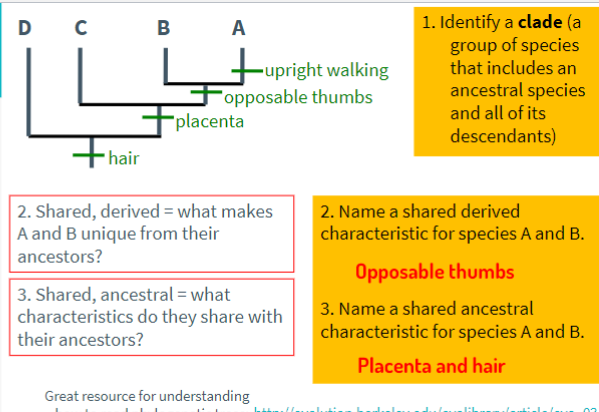UNC BIO 101 LO
1/75
There's no tags or description
Looks like no tags are added yet.
Name | Mastery | Learn | Test | Matching | Spaced | Call with Kai |
|---|
No study sessions yet.
76 Terms
Describe elements of research design and how they impact conclusions (identify strengths and weaknesses in research related to bias, sample size, randomization, etc.)
Elements: hypothesis, control group, experimental group, independent variables, and dependent variables.
Impacts: experiment elements help reduce the amount of bias. The control group helps have a comparison to the experimental group. Sample size gives a big range of data which limits bias as well as randomization
Formulate a testable hypothesis and design a controlled experiment
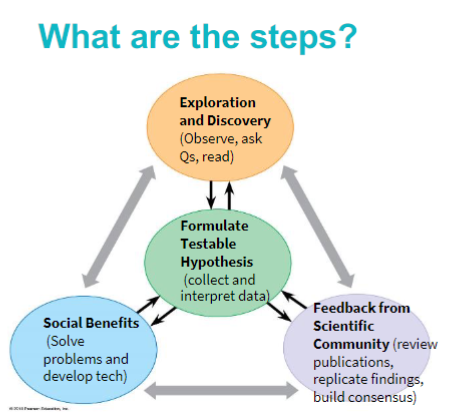
Distinguish science from unjustified claims.
Science consists of hypothesis testing and verifiable evidence. Science is the willingness to follow evidence- and to correct itself when new evidence is found. -Unjustified claims are not supported by any piece of evidence, making them invalid.
Name and explain the five major themes of biology
transformation of energy and matter
structure and function
evolution theory
flow of information
interaction between systems.
Describe how polymers are broken and monomers are joined to form macromolecules in relation to how humans use food.
Polymers are broken down into monomers during digestion & absorption in the small intestine. The four major molecules are proteins, fats, nucleic acid, and carbohydrates.
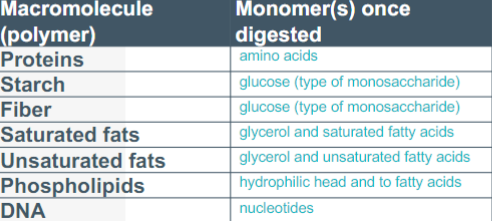
Macromolecules formation/ breakdown
Hydrolysis (water addition)- adding water to the molecule
Dehydration synthesis (water removal)- removing water
What does it mean when a food is nondigestible?
The body (pancreas) does not create an enzyme to breakdown the food.
Identify how the human body uses macromolecules from food.
After hydrolysis the monomers are useful in many ways :
in cellular respiration we break down C6H12O6 (glucose) using chemical energy to useable forms of cellular energy (ATP)
Energy storage: glucose is changed to glycogen through glycogenesis so it can be stored in the liver
building macromolecules are need to preform essential function and growth
Draw protein structure and depict the consequence of mutations on normal structure and function.
The primary structure looks like a beaded necklace. once they are folded into a three-dimensional shape the two amino acids are near each other due to the connection of r-groups
A mutation means it has different r-groups of the amino acids which they will not want to react together.
Explain the molecular forces that hold protein structures together and how they can be disrupted.
Primary structure: held by covalent bonds. STRONGEST bon. broken by enzymes & heat
Secondary Structure: held by hydrogen bonds. Alpha helix, beta pleated sheets. broken by heat and pH.
Tertiary Structure: held by a mix of covalent bonds and hydrogen bonds (R-groups). broken by heat & pH.
Quaternary Structure: two proteins that are folded to a tertiary structure interacting. broken by heat and pH.
Predict structure of the prokaryotic cell that would be antibiotic targets
Prokaryotes cause diseases and antibiotics specifically target them. Thy have DNA, cell membrane, cell wall, cytoplasm, ribosomes.
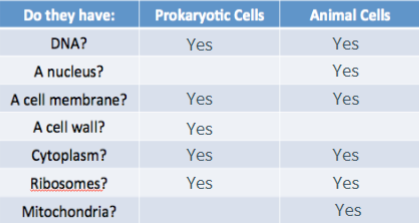
Explain how insulin-producing cells are like dysfunctional factories when a person is diabetic
Type 1- doesn’t have the beta pancreatic cells that produce insulin. Insulin is ABSENT. (autoimmune reaction- their body destroys these cells) they are unable to lower glucose levels in the blood.
Type 2- insulin is PRESENT. it has defective signaling.
Categorize molecules that cross membranes freely and those that do not.
Only non-polar (hydrophobic) molecules can cross the non-polar (hydrophobic) core. some water can cross freely while large amounts need aquaporin.
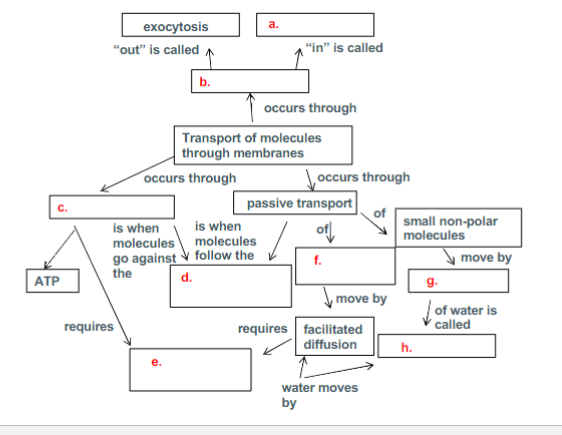
Discriminate between passive transport, active transport, and bulk transport of molecules across a membrane.
Passive Transport- high to low, down the concentration gradient, no energy
Facilitated Diffusion- high to low, requires a transport protein.
Active Transport- low to high, require ATP. against the gradient
BULK TRANSPORT:
Endocytosis- the bulk of molecules into the cell, LDLS
Exocytosis- Bulk of molecules out of the cell
Phagocytosis- bacterium into the cell
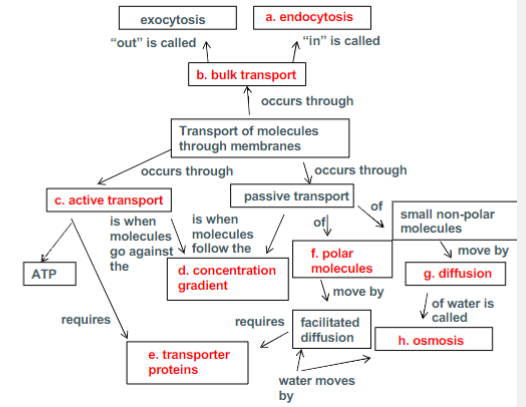
Predict how water will move via osmosis and explain why this is critical to your cells.
water will move from a high concentration of water to a lower concentration.
Hypertonic- higher concentration of solute, low concentration of solution
Hypotonic- low concentration of solute, low concentration of solution
Isotonic- equal amount of solute and solution
Describe how protein is synthesized and exported from a cell and how disease can be caused when this process goes awry
protein is synthesized by starting in the cell nutrient media and then to the Endoplasmic reticulum, then to Golgi bodies, then to secretory vesicles, then to transport vesicles, then to extracellular fluid.
Describe how the two types of chemical signaling mechanisms affect target cells differently.
a single hormone can affect two target cell types differently, Only cells with receptors for a specific hormone can respond to that hormone’s signal.
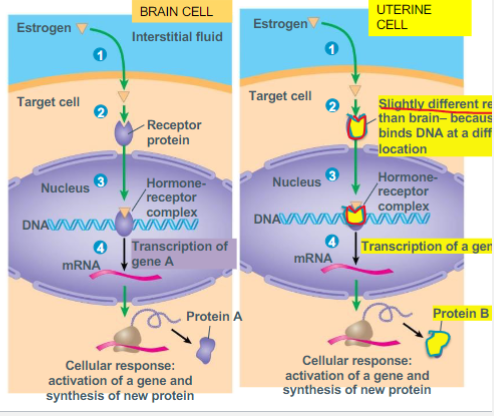
Apply the mechanisms of chemical signaling insulin signaling and sex hormone signaling.
Glucagon release- when blood sugar goes down it stimulates the pancreas. Alpha cells signal the pancreas to release glucagon into the blood. Glucagon receptors are on liver cells. Liver cells break down glycogen stores and return glucose to the blood. Blood sugar levels rise while the stimulus for alpha cells diminishes. The glucose level now reaches a set point.
Insulin Release- When blood glucose level rises it stimulates the pancreas. Beta cells signal the insulin to be released into the blood. Insulin stimulates nearly all cells to take up glucose Liver & muscle cells use glucose to form glycogen. Blood glucose level decreases and the stimulus for beta cells diminishes. The glucose level hit its set point.
Explain the importance of enzymes in metabolism and how they are inhibited.
They build and break matter by lowering the activation energy these reactions require. Coenzymes are organic molecules, cofactors are inorganic molecules. The competitive inhibitor binds to the active site so the substrate cannot bind to the active site. Non-competitive inhibitor changes the shape of the active site making the substrate never bind.
Explain how ATP works
substrate-level phosphorylation; an enzyme adds a phosphate from a molecule to adenosine diphosphate. the product is adenosine triphosphate.
List the inputs and outputs of aerobic cellular respiration and describe the big picture for why cells use this process.
Formula: C6H1206+6O2→6CO2+6H20+32ATP+HEAT
Inputs: glucose oxygen
Outputs: carbon dioxide, water, ATP& heat
Stage 1: Glycolysis (in cytoplasm)
Inputs: glucose
outputs: 2 pyruvate molecules, 2 ATP
Stage 2: Pyruvate oxidation(inner mitochondria)
Inputs: 2 pyruvate molecules
Outputs Acetyl CoA
Stage 2: Citric Acid
Inputs: 2 Co A
Outputs:2 ATP, FADH2,CO2,3NADH
Stage 3: Oxidative phosphorylation (mitochondrion)
Inputs: FADH2, Co2, 3 NADH
Outputs: 28 ATP
Explain how coenzymes are reduced during respiration and how this contributes to ATP formation.
NAD+ is reduced to create NADH
Diagram the major stages of aerobic respiration, noting the location in the cell and the inputs and outputs of each stage.
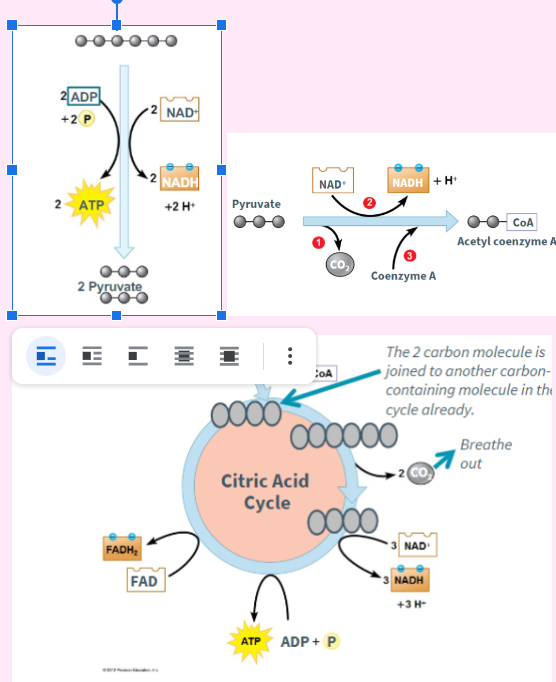
Explain how a H+ gradient and oxygen are both necessary for oxidative phosphorylation.
Brown Fat cells: If oxygen is impaired then the electron cannot be accepted by O2. Not make metabolic water. If electron is not accepted then they can not pass through ETC. This means NADH& FADH are reduced; no NAD+ or FAD to pass electrons to. During glycolysis and pyruvate oxidation. With no oxygen, cells will die because no ATP is made unless it can use anaerobic fermentation.
H+ gradient is very important, in brown fat cells, thermogenic decreases ATP synthesis. No longer is a H+ gradient being built because protons can easily flow through the thermogenic instead of ATP synthase. It produces H20 but little ATP. Chemical energy originally in glucose is now heat.
Describe anaerobic respiration pathways and differentiate them from aerobic pathways.
Require no oxygen and happens in the cytoplasm
ex: Alcohol fermentation and Latic Acid fermentation
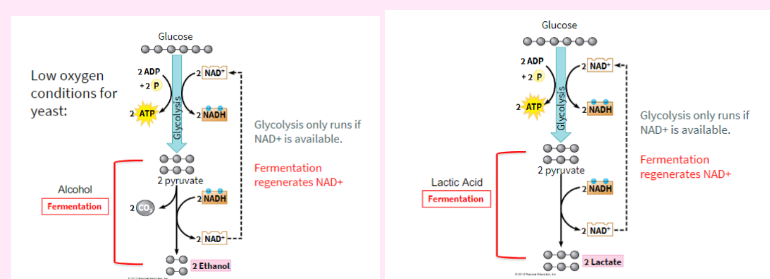
Describe where the mass of a tree comes from, explain how the “mass” is made, and explain how trees are carbon sinks.
The dry mass of tree comes from molecules in the air that came in through holes in the plant’s roots. They use more Co2 for photosynthesis, then they release via cellular respiration
Describe the two parts of photosynthesis and the inputs and outputs of both parts.
Calvin Cycle
Inputs: Co2, ATP, NADPH
Outputs: G3P(3 carbon sugar, NADP+, ADP & P
light reaction
Inputs: light, H2O, NADP+, ADP&P
Outputs: ATP, NADPH, O2
Explain what kind of sunlight is used by the plant and why sunlight is necessary.
It uses light in the PAR range. it does not use violet or red. It is necessary because it is how light-dependent gets its energy.
Explain photophosphorylation in the light reactions of photosynthesis, and describe how photophosphorylation is similar and different from oxidative phosphorylation in aerobic respiration.
mitochondria use oxidative phosphorylation to transfer chemical energy from food into the chemical energy of ATP.
Chloroplast uses photophosphorylation to transfer light energy into the chemical energy of ATP.
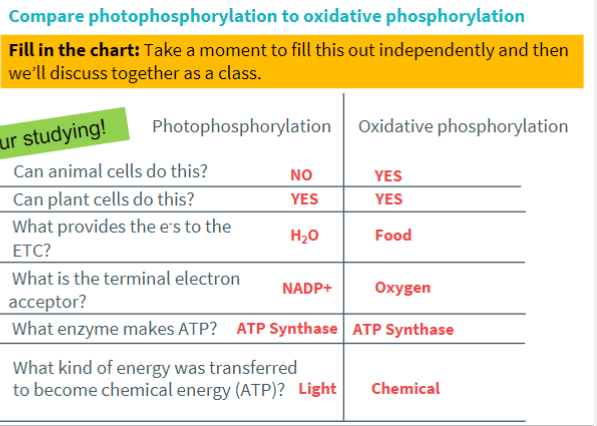
Contrast asexual and sexual reproduction in outcome and types of organisms/cells that use each
Asexual reproduction: one parent; offspring genetically identical to parent & each other; little genetic variation
EX; trees, bacteria, starfish, Komodo Dragón
Sexual reproduction: two parents, offspring genetically different from parents and each other
EX; titan arum and human embryo.
Recognize/draw the stages of mitosis, contrasting animal and plant cells, and explain the consequences of specific stages of mitosis failing.
Animal cells must undergo
grow in size; increase ATP and protein production
double the amount of DNA
double the organelles
ensure daughter cells get half
Interphase is 90% of cell division; it has 3 stages
G1: growth of cell & increase in cytoplasmic contents
S: DNA is doubled (chromosomes duplicate)
G2: growth of cell and increase in cytoplasmic content.
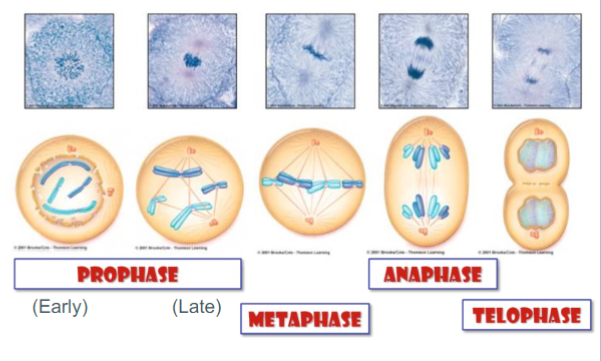
Describe how cell division plays a role in development.
They play a role in development as they make somatic cells like skin cells, bone marrow, liver cells and much more
Explain how cells know when it is time to divide.
Two kinds of cell division
Stimulative: a “go” signal must be present to divide
Mutation in genes that stimulate cell division contributes to cancer. “over acceleration”
Genes that normally stimulate cell division are called proto-oncogenes, so mutation in these genes can lead to cancer
Inhibitive: a “stop” signal must not be present to divide.
Mutation in genes that inhibit cell division contributes to cancer by having “faulty breaks”
Genes that normally inhibit cell division are called tumor suppressors, so a mutation in these genes can lead to cancer.
Explain how cancer cells disobey the rules that normal cells follow in the cell cycle and in cell growth.
Normal cells adhere to the tissue they are supposed to be in. Cancer cells may migrate. Normal cells are “density-dependent inhibited” Cancer cells will grow on top of each other in a disorganized fashion.
Define haploid, diploid, and homologous chromosomes.
Haploid: one set of chromosomes
Diploid: two sets of chromosomes one from each parent.
Homologous chromosomes: pairs of chromosomes: that have the same genes but different alleles
Explain how the process of meiosis differs from mitosis and how these differences explain the variation seen in sexual reproduction.
homologous chromosomes pair and crossing over occurs in prophase 1
offspring is NOT identical to each other b/c of swapping parts of DNA of mom & dad copies are next to each other
meiosis makes sex cells
Genetic content is halved.
Draw how variation arises during meiosis from independent orientation at metaphase I.
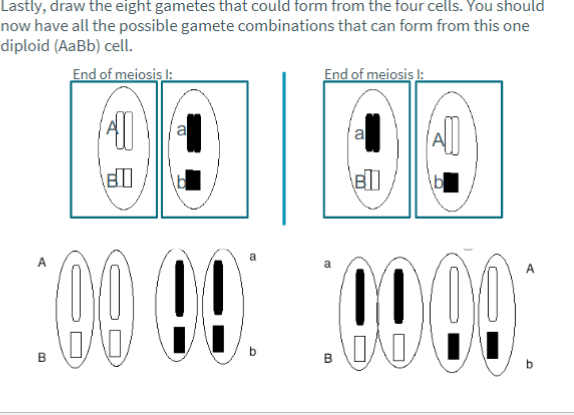
Construct Punnett squares.
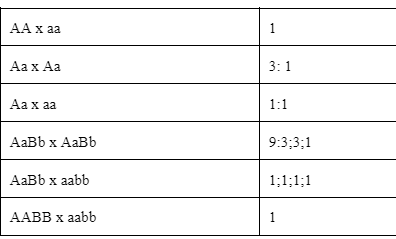
Determine the mode of inheritance of a pedigree (autosomal dominant or recessive or X-linked recessive).
If every generation is filled it is autosomal dominant
if it skips a generation it is autosomal recessive
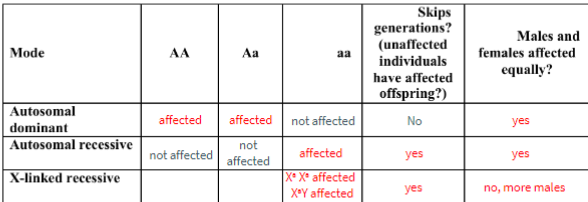
Calculate probabilities when given pedigrees.
Tips:
Make up various pedigrees (draw your own)
for the three modes of inheritance.Pick people in the pedigrees and write their
genotypes or possible genotypes.Make two different pedigrees of the same
disease (i.e. two of X-linked hemophilia) and
pick an individual from each pedigree to ask
questions about the risk their offspring would
have a disease.
Mendel’s law reviewed
law of segregation: 1 allele for each gene placed in different gametes
Law of independent assortment: inheritance of one gene does not affect the inheritance of other genes
Recognize and/or solve problems that are non-medallion variations of inheritance (incomplete dominance, co-dominance, multiple alleles, alleles pleiotropy, and polygenic traits)
Complete dominance: The dominant allele fully overrides the recessive allele to determine the phenotype.
Incomplete dominance: partial expression of both alleles that result in a blended phenotype
Co-dominance: both alleles are simultaneously expressed in different parts of the organism or both alleles show dominance.
Pleiotropy: one gene can be responsible for many different symptoms depending on where it is expressed
Polygenic: multiple genes work together to make the final outcome. EX: skin color.
Draw a basic model of DNA, being able to point out where DNA variation is part of the structure.
Variation comes from the order of nucleotides
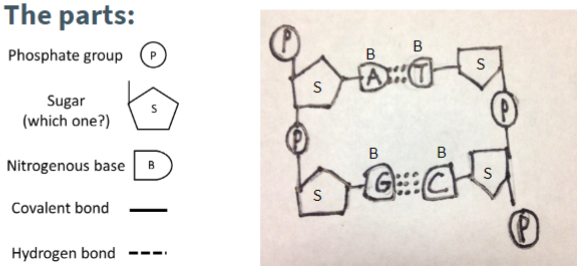
Distinguish what makes somatic cells in the body similar and what makes them different.
similar: they have identical DNA except for sex cells
difference: which mRNA’s and proteins are being expressed or not expressed. by expressed biologist means transcribed and translated.
Trace a specific DNA sequence all the way to the protein.
Calculate the variations in code that lead to the same protein.
Calculate variation in proteins of the same size.

Define an allele at the molecular level and describe some outcomes of changes in the DNA.
just a different version of a gene, one from mom and dad
any change in the nucleotide sequence in the DNA of a cell is a mutation
Information of mutation
Missense: a change in a nucleotide leading to an amino acid change may or may not affect protein function
Frameshift: a change in the reading frame due to a nucleotide insertion or deletion. usually devastating effect on protein function
Silent mutation: a change in nucleotide sequence that does not impact the amino acid sequence
Nonsense mutation: a change in the nucleotide sequence that introduces a stop codon in an inappropriate location.
Use genetic and molecular data to determine an individual’s phenotype.
An organism's phenotype is determined by its genotype, which is the set of genes the organism carries, as well as by environmental influences upon these genes.
Explain how “emergent properties” arise from the structure and function of individual components of a system.
B cells, T Cell, and antibodies; novel function: Defenses against viruses
Give examples of homeostasis in the body and the consequences of imbalance
when body heat rises, you begin to sweat
when you get cold the body finds a way to heat up
heartbeats
hormone levels
breathing rate
Describe the basic components of the immune system.
First line of defense: at birth; immediate; nonspecific responses; no memory
external innate defenses
skin, acidic environment, secretion, mucous membrane, hair, cilia
internal innate defense
phagocytic cells, natural killer, cells, defensive proteins, inflammatory response
Second line of defense: developed overtime; slower, specific response; has memory
adaptive defenses carried by lymphocytes (b and t cells)
Humoral
B cells
produces antibodies
extracellular (pathogen in body fluids)
Cell-mediated immunity
T cells
Pokes holes in infected cells
targets intracellular pathogens
Compare and contrast humoral and cell-mediated immunity.
Humoral
B cells
produces antibodies
extracellular (pathogen in body fluids)
bind to invading bacteria and viruses and mark them for destruction by phagocytes
Cell-mediated immunity
T cells
Pokes holes in infected cells
targets intracellular pathogens
Explain how vaccines work with the adaptive immune system
vaccine provides an inactivated virus that provides enough antigens so the body has a primary immune response and builds memory cells to the virus.
herd immunity is important so it protect the weak and sic
Describe the structure and function of male and female anatomy.
Male anatomy
semen: 95% glandular secretions; 5% sperm
Three glands produce sperm
seminal vesicle: produces mucus and fructose to produce ATP to support swimming
prostate: milky fluid with proteins
An enlarged prostate leads to difficult urination.
Bulbourethral: alkaline mucus to counteract acidity in the urethra and vagina, lubrication helps the sperm swim through the vagina and cervix.
Path of sperm
Testis → epididymis → vas deferens → ejaculatory duct → urethra
Vagina → cervix → uterus → oviduct
Discuss the prevention and consequences of various sexually transmitted infections
Viral: NOT CURABLE
Herpes: sore, itching, red bumps, blisters ;no cure but antiviral medication; can’t get a second time.
HPV (Human papillomavirus): wart;no cure but antiviral medication, can’t get a second time. 99% of cervical cancer are caused by HPV, there is a vaccine
Bacterial: IS CURED
Chlamydia: burning pee, antibodies medication that can cure, can get multiple times.
Gonorrhea: burning pee, yellow-white discharge, antibody medication that can cure, can get multiple times.
Illustrate how the hormones and anatomy of the reproductive age female change over a month--with and without pregnancy.
Pre-ovulation
The hypothalamus secretes hormones to cause the release of pituitary hormones
The pituitary releases low levels of FSH& LH
In response the follicle cells make more and more estrogen
a peak of estrogen causes a bust of LH
releases of the secondary oocyte
Post- ovulation
A ruptured follicle known as the corpus luteum produces estrogen and progesterone leading to the thickening of the uterus wall.
NO pregnancy:
when the egg is not fertilized during ovulation the embryo doesn’t implant leading to the corpus luetum degenerating
progesterone and estrogen fall and the new cycle begins
WITH Pregnancy:
HCG hormone is introduced
HCG from the embryo provides positive feedback to the corpus luteum to keep producing estrogen and progesterone
progesterone and estrogen prevent new follicles from developing.
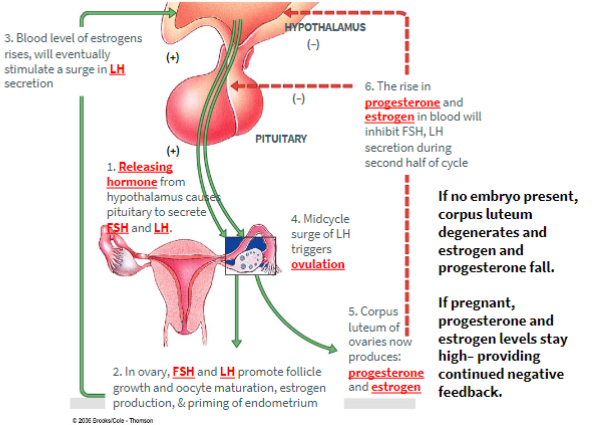
Explain IVF and how the pill prevents pregnancy.
IVF is a test tube baby
FSH and LH are given to females to stimulate egg production
Birth control
Has estrogen and progesterone to mimic post-ovulation of negative feedback to keep new follicle from developing and prevent ovulation
Determine if two organisms are from the same species. Be able to explain the benefits and drawbacks of different definitions of a species
Explain the uses for the biological species concept of species and its limitations
biological species concept- potential to interbreed and produce fertile offspring
morphological: have shared physical traits
ecological: unique role in a community
phylogenetic: groups that share a common ancestor
Explain the uses for the biological species concept of species and its limitations
Phenology: a study of the timing of periodic life cycle events for a species
ex: migration, habitat, mating, production of fruit
Explain how scientists estimate population size and perform calculations.
mark-capture/catch-release
Marked individual sampling at time 1 / total population size (n) = marked individual at time 2 / total captured in sampling 2
Use the exponential growth model t calculate population growth.
R= g(net)/N
G= rn
Compare and contrast logistic and exponential models of growth.
Logistic G=rn (k-N)/ K
Explain the difference between density-dependent and independent population change.
Density -dependent
lac of space
lack of food
increased disease
stress leading to decreased reproduction
accumulation of waste
predator
Density Independent
random
natural disasters
Describe the difference between population and community ecology
Population ecology
how does an organism pop. rise and fall throughout the year in its environment?
Community ecology
how does organism of species compete for resources with other species?
Explain the consequence when two species have an identical niche.
Species that use resources quicker will outcompete the other species and survive better.
Two species cannot coexist w/ identical niche
Resource partitioning- eating different things, so no competition for food
Describe and give examples of five types of community interactions.
Competition
Negative effect on both species
Parasitism
Positive effect on one species and negative on the other
Predation
Positive effect on one species and negative on the other
Herbivory
positive effect on one species and negative on the other
Mutualism
Positive effect on both species
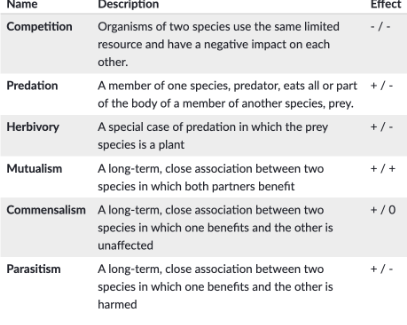
Distinguish components of the theory of natural selection that are true vs. common misconceptions.
Evolution theory deals mainly with how life changed after its origin
Evolution is not like a climb up a ladder, organisms do not always get better. GOOD ENOUGH IS GOOD ENOUGH
Evolution is not entirely chance, there are non-random evolutionary processes
Natural Selection DOES NOT give organisms what they need to adapt to an environment
If a population happens to have the genetic variation that allows some individuals to survive things better than others, then they will produce more offspring
If that genetic variation that helps them adapt is not in the population, then the population may still survive or may die out
Evolution is a theory that is not losing strength because it is not debatable whether it took place. The show is debated.
Distinguish creationist, theistic, and naturalistic views and what polls about evolution tell us about Americans and countries worldwide.
Science- explanations based on evidence drawn from examining natural world
Religious belief- does not depend on empirical evidence, normally involves supernatural forces/entities that cannot be investigated by science
SCIENCE IS NOT ABOUT FAITH OR BELIEF. IT IS TESTABLE
Explain what science is and why the study of evolution is a science
Evolution is observable & testable through scientific experiments
Scientific theories are testable
Explain Darwin’s ideas about natural selection and how his ideas were better understood once combined with Mendel’s work.
Natural selection= differential reproductive success
Characteristics of individuals that allow them to best adapt to their current environment that give them the ability to most likely to survive and reproduce
Populations is the smallest unit that can evolve
Natural selection does not create variations
Variation already exists in a population
Natural selection is an editing process, contingent on time & place
Significant evolutionary change can occur in a short time (a few generations)
Natural Selection= Modern synthesis (1940s)- the ideas of Darwin and mendel together
How is it different from drawings theory of NS
Recognizes 4 processes of evolution (gene flow, genetic drift, and mutation)
Recognizes “traits” are genes
NS acts on individuals but effect is change in population
Population: group of organisms of same species living at same time/place
microevolution : a change in allele frequency overtime
Explain the conditions that must be met for non-evolution.
Hardy Weinburg model of non-evolving population (aka equilibrium)
Do non-evolving populations exist? NOPE
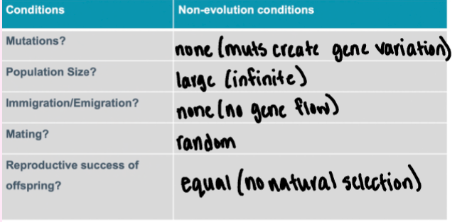
Perform Hardy Weinberg calculations
p+q=1 ALLELE FREQUENCIES
p2+2(p)(q)+q2=1 GENE FREQUENCIES

Recognize what form of microevolutionary force is a driving force in examples of evolution.
Explain how genetic drift, mutation, gene flow, and natural selection affect allele frequency in a population.
Natural selection can alter variation in 3 ways
Directional
Shifts overall makeup of population by acting against individuals at one of phenotype extremes
Think slanted graph
Stabalizing
Favors intermediate variants by acting against extreme phenotypes
Think middle column
Disruptive
Favors extreme phenotypes, leading to two ot motre contrasting phenotypes in population
Think dip in middle
Sexual selection is a form of NS
Individuals with certain traits are more likely to obtain mates
Intersexual- betwen sexes
Intrasexual-within (competetion)
Mutations are labled good, bad or neutral depending on enviornmnetal change
Founder effect-small grpoips splits off from main group to form new colony
Bottleneck effect-population reduced in size by natrual disaster
Balancing selection-maintains genetic diversity;favors multiple alleles
Difference between balancing and stabalixzing is that stabalizing DOES not favor genetic diversity and instead decreases it
Define the conditions that lead to speciation.
The factors responsible for speciation are:
Geographical barrier.
Natural selection.
Genetic drift.
Large mutation.
Distinguish various reproductive barriers that keep species separate.
Pre-zygotic
Temporal Isolation: different mating time
Habitat Isolation: species can mate but live in different habitat
Mechanical Isolation: the sexual parts don’t fit
Behavioral Isolation: species avoid the other species because they do not like their behavior
Genetic Isolation: eggs & sperm don’t have the same proteins
Post-zygotic
Reduced hybrid viability: offspring dies before mating
Reduced Hybrid fertility: offspring is not fertile
Hybrid breakdown: second generation of offspring are week
Construct a phylogenetic tree when given morphological data and a list of organisms
Each branching event of circle represents a common ancestor
